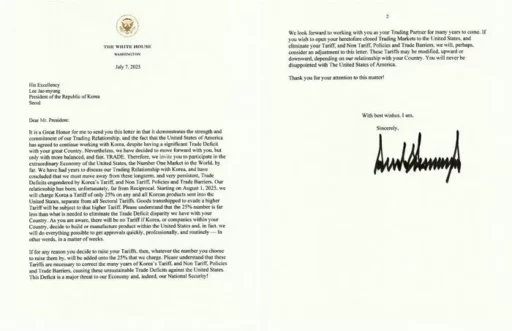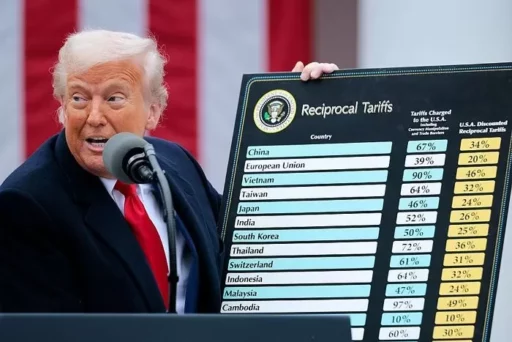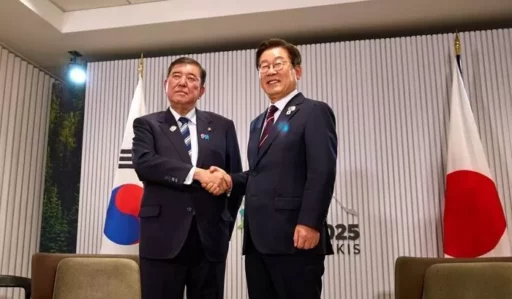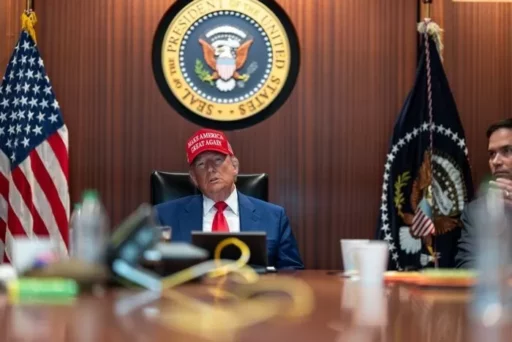Trump's 'Tariff Bomb': The First Targets are South Korea and Japan
U.S. President Donald Trump has identified South Korea and Japan as the first targets for a 25% mutual tariff by sending letters proposing the tariffs to both nations.
On the 7th (local time), President Trump sent identical letters to President Lee Jae-myung of South Korea and Prime Minister Shigeru Ishiba of Japan, which he subsequently disclosed on Truth Social.
The letters contained the statement that “from August 1, a tariff of 25% will be imposed on all Korean products imported into the United States, in addition to sector-specific tariffs.”

President Trump asserted that “we must now change direction to resolve the long-standing trade deficit caused by Korea’s tariffs, non-tariffs, policies, and trade barriers.” He added that “the figure of 25% is significantly lower than what is necessary to resolve the trade deficit gap with your country,” implying a threat that if South Korea raises its tariffs on the U.S., he would add that amount to the 25%.
Trump's Strategic Focus on Allies
It is significant that President Trump specifically chose South Korea and Japan, both manufacturing powerhouses and security allies of the U.S., as his first targets for tariff notifications.
On the same day, Trump also formally notified five countries—Malaysia, Kazakhstan, Laos, Myanmar, and South Africa—of the new tariff rates. However, the public disclosure of the letters sent to South Korea and Japan is seen as having political implications.
Ian Bremmer, Chairman of the Eurasia Group, remarked in a recent interview with the Ministry of Trade, Industry and Energy that “President Trump views South Korea and Japan almost through the same geopolitical lens.”

In terms of trade, the U.S. also seems to recognize similarities between South Korea and Japan.
Both countries have recorded trade surpluses with the U.S. through manufactured goods such as automobiles and are making significant investments in the U.S. Such exports and investments positively contribute to the American economy, and there are emerging criticisms that the Trump administration is not properly acknowledging this.
Both countries have recorded trade surpluses with the U.S. through manufactured goods such as automobiles.
Tariff Pressure as a Bargaining Tool
White House Press Secretary Caroline Levitt emphasized during a press conference that “President Trump is establishing tailored trade plans for every country on this planet.”
He claimed that “the President is actually looking at the map and examining all countries on Earth to identify those that have deceived American citizens, weakened our industrial base, and moved American jobs overseas due to tariff policies.”

The fact that South Korea and Japan are the first targets is paradoxically due to their status as allies. President Trump's usual perception is that the closer the alliance, the more the allies have “sucked the life out” of the U.S., and this tariff notification can be viewed as a bill for the allies to pay.
Paradoxically due to their status as allies, the closer the alliance, the more the allies have “sucked the life out” of the U.S.
Moreover, by targeting countries with fewer unexpected response cards, unlike China, there is also an intention to set an example for other nations.
Interpreted as an arbitrary number, the 25% tariff rate suggested by the U.S. is seen as close to a random figure, similar to that announced on April 2.
Treasury Secretary Scott Vestant has already stated that a 10% tariff rate will be applied to over 100 countries, serving as a baseline tariff rate for countries that are not key trading partners, indicating that countries involved in negotiations should expect even higher rates.
What the Trump administration prioritizes is a demonstrable victory in negotiations that can be showcased to the American public. Even in alliances, there is an effort to overtly display control over negotiation terms to maintain U.S. superiority. The fact that President Trump repeatedly mentions intuitively clear issues like rice or automobiles in past negotiations with Japan serves to effectively appeal to American citizens.

Room for Negotiation Remains
Considering the 'pattern' of the Trump administration using tariffs as leverage, the current proposed tariff rates have the potential to be adjusted during negotiations.
On the 7th, during a dinner meeting at the White House with Israeli Prime Minister Benjamin Netanyahu, President Trump stated, “If they (the negotiation counterpart) call with another proposal and I like it, we will make that change.”
Regarding the deadline of August 1, he added, “I cannot say it is 100% solid. If they call and say 'we want to do something differently,' we would be open to that.”
Meanwhile, the Ministry of Trade, Industry and Energy stated, “We view this letter as effectively extending the mutual tariff imposition grace period until August 1, and to quickly eliminate uncertainties caused by tariffs, we will accelerate negotiations to achieve mutually beneficial results during the remaining period.”
The economic sector is also anticipating additional negotiations from the government during the grace period of effectively 'tariff exemption.'
Previously, as the end of the mutual tariff imposition grace period approached, the government dispatched Lee Han-koo, head of the Trade Negotiation Headquarters, and on the 7th sent Suh Hoon, head of the National Security Office, to the U.S. to express our government's stance. Former National Power Party emergency response chairperson Kim Jong-in is also designated as a special envoy to the U.S. to expand dialogue.
The government is demanding significant reductions in mutual tariffs while seeking item-specific tariff reductions on automobiles, steel, pharmaceuticals, and more.
Lee Han-koo stated, “Since the item-specific tariffs are highly valued from the perspective of U.S. industrial protection, we expect the negotiations to be relatively difficult. However, we have emphasized that exceptions or significant reductions of item-specific tariffs are important from our perspective, and we plan to reiterate this again today.”
He emphasized, “It is essential to find a balance by properly coordinating the potential for trade friction with our domestic policy goals.”
As the current government aims for economic revitalization between the two countries through a 'manufacturing partnership,' it is expected that there will be increased efforts to create a negotiation proposal closer to President Trump's desired 'good deal.'
Image source: Photos = Truth Social, U.S. President Donald Trump / Getty Images Korea. President Lee Jae-myung had a Korea-Japan summit with Prime Minister Shigeru Ishiba of Japan at the G7 venue in Canmore, Alberta, Canada on June 17, 2025 / News1 (Presidential Office), U.S. President Donald Trump / x 'White House', News1.


